SOFTWARE TESTING W4_watermark.pdf
- 2. 2 Integration Testing Approaches • Develop the integration plan by examining the structure chart : –big bang approach –top-down approach –bottom-up approach –mixed approach
- 3. 3 Example Structured Design M1 M3 M4 M2 M7 M6 M5 M8 M7
- 4. 4 Big Bang Integration Testing • Big bang approach is the simplest integration testing approach: –All the modules are simply put together and tested. –This technique is used only for very small systems.
- 5. 5 Big Bang Integration Testing • Main problems with this approach: –If an error is found: • It is very difficult to localize the error • The error may potentially belong to any of the modules being integrated. –Debugging becomes very expensive.
- 6. 6 Bottom-up Integration Testing • Integrate and test the bottom level modules first. • Disadvantages of bottom-up testing: –Drivers have to be written. –Test engineers cannot observe system level functions from a partly integrated system.
- 8. 8 Example Bottom-up Testing M1 M3 M4 M2 M7 M6 M5 M8 M7 In Bottom Up testing : – M5-M8 is tested with drivers for M5 – M5-M6-M8 is tested with drivers for M5-M6 – …
- 9. 9 Top-down Integration Testing • Top-down integration testing starts with the top module: –and one or two subordinate modules • After the top-level 'skeleton’ has been tested: –Immediate subordinate modules of the 'skeleton’ are combined with it and tested.
- 11. 11 Top-down Integration Testing M1 M3 M4 M2 M7 M6 M5 M8 M8 • In Top Down test: – M1-M2 tested with stubs for M3, M4, M5 and M6 – M1-M2- M3 tested with stubs for M4 M5, and M6 – Then M1-M2-M3-M4 tested with stubs for M5, M6, M7 and M8
- 12. 12 Top-Down Integration • Advantages of top down integration testing: – Test cases designed to test the integration of some module are reused after integrating other modules at lower level. – Advantageous if major flaws occur toward the top of the program. • Disadvantages of top down integration testing: – It may not be possible to observe meaningful system functions because of an absence of lower level modules which handle I/O. – Stub design become increasingly difficult when stubs lie far away from the level of the module.
- 13. 13 Mixed Integration Testing • Mixed (or sandwiched) integration testing: –Uses both top-down and bottom- up testing approaches. –Requires less stubs and drivers
- 15. 15 Integration Testing • In top-down approach: –Integration testing waits till all top-level modules are coded and unit tested. • In bottom-up approach: –Testing can start only after bottom level modules are ready.
- 16. 16 System Testing • Objective: –Validate a fully developed software against its requirements.
- 17. 17 System Testing • There are three main types of system testing: –Alpha Testing –Beta Testing –Acceptance Testing
- 18. 18 Alpha Testing • System testing carried out by the test team within the developing organization. –Test cases are designed based on the SRS document
- 19. 19 Beta Testing • System testing performed by a select group of friendly customers.
- 20. 20 Acceptance Testing • System testing performed by the customer himself: –To determine whether the system should be accepted or rejected.
- 22. 22 Types of System Testing • Two types: –Functionality: Black-box test cases are designed to test the system functionality against the requirements. –Performance: Tests are designed against the non-functional requirements documented in the SRS document.
- 23. 23 Performance Tests • Stress tests • Volume tests • Configuration tests • Compatibility tests • Security tests • Load test • Recovery tests • Maintenance tests • Documentation tests • Usability tests • Environmental tests
- 24. 24 Stress Testing • Stress testing (also called endurance testing): –Impose abnormal input to stress the capabilities of the software. –Input data volume, input data rate, processing time, utilization of memory, etc. are tested beyond the designed capacity.
- 25. 25 Stress Testing • Stress testing usually involves an element of time or size, – Such as the number of records transferred per unit time, – The maximum number of users active at any time, input data size, etc. • Therefore stress testing may not be applicable to many types of systems.
- 26. 26 Stress Testing Examples • If an operating system is supposed to support 15 multiprogrammed jobs, – The system is stressed by attempting to run 15 or more jobs simultaneously. • A real-time system might be tested – To determine the effect of simultaneous arrival of several high-priority interrupts.
- 27. 27 Load testing • Load testing: – Determines whether the performance of the system under different loads acceptable? – Example: For a web-based application, what is the performance of the system under some specified hits? • Tool: – JMeter: http://jakarta.apache.org/jmeter/
- 28. 28 Volume Testing • Tests whether handling large amounts of data in the system is satisfactory: – Whether data structures (e.g. queues, stacks, arrays, etc.) are large enough to handle all possible situations. – Fields, records, and files are stressed to check if their size can accommodate all possible specified data volumes.
- 29. 29 Configuration Testing • Sometimes systems are built in various configurations for different users – for instance, a minimal system may serve a single user, other configurations for additional users. • Test system behavior: – in various hardware and software configurations specified in requirements
- 30. 30 Compatibility Testing • These tests are needed when the system interfaces with other systems: – Check whether the interface functions as required. • Example: For a web-based application, check whether the application works satisfactorily with various web browsers.
- 31. 31 Compatibility Testing: Another Example • If a system is to communicate with a large database system to retrieve information: – A compatibility test examines speed and accuracy of retrieval.
- 32. 32 Recovery Testing • These tests check response to: –The loss of data, power, devices, or services –Subject system to loss of resources •Check if the system recovers properly.
- 33. 33 Maintenance Testing • Diagnostic tools and procedures help find source of problems. – It may be required to supply • Default configurations • Diagnostic programs • Traces of transactions, • Schematic diagrams, etc. • Verify that: – all required artefacts for maintenance exist – they function properly
- 34. 34 Documentation tests • Check whether required documents exist and are consistent: – user guides, – maintenance guides, – technical documents • Sometimes requirements specify: – Format and audience of specific documents – Documents are evaluated for compliance
- 35. 35 Usability tests • All aspects of user interfaces are tested: –Display screens –messages –report formats –navigation and selection problems
- 36. 36 Environmental test • These tests check the system’s ability to perform at the installation site. • Requirements might include tolerance for – heat – humidity – chemical presence – portability – electrical or magnetic fields – disruption of power, etc.
- 37. 37 Test Summary Report • Generated towards the end of testing phase. • Covers each subsystem: –A summary of tests which have been applied to the subsystem.
- 38. 38 Test Summary Report • Specifies: – how many tests have been applied to a subsystem, – how many tests have been successful, – how many have been unsuccessful, and the degree to which they have been unsuccessful, • e.g. whether a test was an outright failure • or whether some expected results of the test were actually observed.
- 40. 40 Latent Errors: How Many Errors are Still Remaining? • Make a few arbitrary changes to the program: –Artificial errors are seeded into the program. –Check how many of the seeded errors are detected during testing.
- 41. 41 Error Seeding • Let: –N be the total number of errors in the system –n of these errors be found by testing. –S be the total number of seeded errors, –s of the seeded errors be found during testing.
- 42. 42 Error Seeding • n/N = s/S • N = S n/s • remaining defects: N - n = n ((S - s)/ s)
- 43. 43 Quiz 1 • 100 errors were introduced. • 90 of these errors were found during testing • 50 other errors were also found. • Find error estimate for the code.
- 44. 44 • 100 errors were introduced. • 90 of these errors were found during testing • 50 other errors were also found. • Remaining errors= 50 (100-90)/90 = 6 Quiz 1: Solution
- 45. 45 Error Seeding: An Issue • The kinds of seeded errors should match closely with existing errors: –However, it is difficult to predict the types of errors that exist. • Working solution: –Estimate by analyzing historical data from similar projects.
- 46. 46 Quiz 2 • Before system testing 100 errors were seeded by the manager. • During system testing 60 of these were detected. • 150 other errors were also detected • How many unknown errors are expected to remain after system testing?
- 47. 47 What is regression testing? Regression testing is testing done to check that a system update does not cause new errors or re- introduce errors that have been corrected earlier.
- 48. 48 Program b=b+5; a=a*b; T1 T2 T3 T5 T4 Why regression testing? Failure
- 49. 49 Need for Regression Testing • Any system during use undergoes frequent code changes. –Corrective, Adaptive, and Perfective changes. • Regression testing needed after every change: –Ensures unchanged features continue to work fine.
- 50. 50 Tor Optimized Regression Tests To Obsolete Tu Redundant Tr Regression Tests Partitions of an Existing Test Suite
- 51. 51 Automated Regression Testing • Test cases that have already run once: – May have to be run again and again after each change – Test cases may be executed hundreds of time – Automation very important… • Fortunately, capture and replay type tools appear almost a perfect fit: – However, test cases may fail for reasons such as date or time change – Also test cases may need to be maintained after code change
- 52. 52 Major Regression Testing Tasks • Test revalidation (RTV): – Check which tests remain valid • Test selection (RTS): – Identify tests that execute modified portions. • Test minimization (RTM): – Remove redundant tests. • Test prioritization (RTP): – Prioritize tests based on certain criteria.
- 53. 53 Software Regression Process Software Change Analysis Software Change Impact Analysis Select Regression Tests Report Retest Results Run Regression Tests at different levels
- 55. 55 Quiz • Is regression testing a unit, integration, or system testing technique? • Answer: It is used in all of these testing. Actually it is a different dimension of testing.
- 56. 56 Introduction • More than 50% of development effort is being spent on testing. • Quality and effective reuse of software depend to a large extent: – on thorough testing. • It was expected during initial years that OO would help substantially reduce testing effort: – But, as we find it out today --- it only complicates testing.
- 57. 57 Challenges in OO Testing • What is an appropriate unit for testing? • Implications of OO features: – Encapsulation – Inheritance – Polymorphism & Dynamic Binding, etc. • State-based testing • Test coverage analysis • Integration strategies • Test process strategy
- 58. 58 What is a Suitable Unit for Testing? • What is the fundamental unit of testing for conventional programs? – A function. • However, as far as OO programs are concerned: – Methods are not the basic unit of testing. • Weyukar's Anticomposition axiom: – Any amount of testing of individual methods can not ensure that a class has been satisfactorily tested.
- 59. 59 Suitable Unit for Testing OO Programs • Class level: – Testing interactions between attributes and methods must be addressed. – State of the object must be considered.
- 60. 60 Weyukar’s Anticomposition Axion (IEEE TSE Dec. 1986) • Adequate testing of each individual program components does not necessarily suffice to adequate test the entire program. • Consider P and Q as components: – P has the opportunity to modify the context seen by Q in a more complex way than could be done by stubs during testing of components in isolation. • What is the interpretations for OO programs?
- 61. 61 Encapsulation • Encapsulation is not a source of errors: – However, an obstacle to testing. – It prevents accessing attribute values by a debugger. • While testing: – Precise information about current state is necessary.
- 62. 62 Solving Encapsulation- Related Problems Several solutions are possible: –Built-in or inherited state reporting methods. –Low level probes to manually inspect object attributes. –Proof-of-correctness technique (formal).
- 63. 63 Solving Encapsulation-Related Problems • Most feasible way: –State reporting methods. • Reliable verification of state reporting methods is a problem.
- 64. 64 Inheritance • Should inherited methods be retested? – Retesting of inherited methods is the rule, rather than an exception. LibraryMember Research PostGrad UnderGrad Staff Students Faculty Base Class Derived Classes
- 65. 65 Should Inherited Methods be Retested? • Retesting required: – Because a new context of usage results when a subclass is derived. (Anticomposition axiom) • Correct behavior at an upper level: – Does not guarantee correct behavior at a lower level.
- 66. 66 Example Class A{ Protected int x=200; //invariant x>100 Void m(){//correctness depends on invariant} } Class B extends A{ void m1(){x=1; …} …} • Execution of m1() causes a bug in m() • Breaks the invariant, m is incorrect in the context of B, even though it is correct in A: - Therefor m should be retested in B
- 67. 67 Another Example Class A{ Void m(){ … m2(); … } Void m2() {…} } Class B extends A{ void m2(){…} …} • M2 has been overridden in B, can affect other methods inherited from A such as m() - m() would now call B. m2. - So, we cannot be sure that m is correct anymore, we need to retest it with B instance
- 68. 68 Inheritance --- Overriding • In case of method overriding: –Need to retest the classes in the context of overriding. –An overridden method must be retested even when only minor syntactic changes are made.
- 69. 69 Which Methods to Test Within A Class? • New methods: – Defined in the class under test not inherited or overloaded by methods in a super class: – Complete testing • Inherited methods: – Defined in a superclass of the class under test: Retest only if the methods interacts with new or redefined method. • Redefined methods: - Defined in a superclass of but redefined class under test: complete Retest
- 70. 70 Regression Testing Derived Class: Example • Principle: inherited methods should be retested in the context of a subclass • Example: if we change a method show-address() in a super class, we need to retest show- address() and other dependent methods inside all subclasses that inherit it. LibraryMember Show-address() Research PostGrad UnderGrad Staff Students Faculty Base Class Derived Classe
- 71. 71 Deep Inheritance Hierarchy • A subclass at the bottom of a deep hierarchy: – May have only one or two lines of code. – But may inherit hundreds of features. • This situation creates fault hazards: – Similar to unrestricted access to global data in procedural programs. • Inheritance weakens encapsulation.
- 72. 72 Deep Inheritance Hierarchy cont... • A deep and wide inheritance hierarchy can defy comprehension: – Lead to bugs and reduce testability. – Incorrect initialization and forgotten methods can result. – Class flattening may increase understandibility. • Multiple Inheritance: – Increases number of contexts to test.
- 73. 73 Abstract and Generic Classes • Unique to OO programming: – Provide important support for reuse. • Must be extended and instantiated to be tested. • May never be considered fully tested: – Since need retesting when new subclasses are created.
- 74. 74 Testing an Abstract Class • Not possible to directly test it. • Can only be indirectly tested through classes derived from it. • So can never be considered as fully tested. LibraryMember Research PostGrad UnderGrad Staff Students Faculty Abstract Class Derived Classes
- 75. 75 Polymorphism • Each possible binding of a polymorphic component requires separate testing: –Often difficult to find all bindings that may occur. –Increases the chances of bugs . –An obstacle to reaching coverage goals.
- 76. 76 Polymorphism cont… • Polymorphism complicates integration planning: –Many server classes may need to be integrated before a client class can be tested. C S1 S2 S3
- 77. 77 Dynamic Binding • Dynamic binding implies: – The code that implements a given function is unknown until run time. – Static analysis cannot be used to identify the precise dependencies in a program. • It becomes difficult to identify all possible bindings and test them.
- 78. 78 Dynamic Binding: the combinatorial explosion problem Class member{ ... abstract boolean validatePayment(Account a, int amt, Card c) ; … } GoldMember SilverMember OrdMember IndianAccount UKAccount EUAccount JPAccount OtherAccount VISACard AmExpCard DebitCard
- 79. 79 How many test cases for pair wise testing? m m1 m5 m11 m15 m51 m55
- 80. 80 State-Based Testing • The concept of control flow of a conventional program : – Does not map readily to an OO program. • In a state model: – We specify how the object's state would change under certain conditions.
- 81. 81 State-Based Testing • Flow of control in OO programs: – Message passing from one object to another • Causes the receiving object to perform some operation, – can lead to an alteration of its state.
- 82. 82 State-Based Testing cont... • The state model defines the allowable transitions at each state. • States can be constructed: –Using equivalence classes defined on the instance variables. • Jacobson's OOSE advocates: –Design test cases to cover all state transitions.
- 83. 83 An example of A State Model Unprocessed Order Rejected Order Pending Order Fulfilled Order Accepted Order [reject] checked [accept] checked [some items available] Processed/deliver [all items available] newsupply [some items not available] Processed Example: State chart diagram for an order object
- 84. 84 State-Based Integration Testing cont... • Test cases can be derived from the state machine model of a class: –Methods result in state transitions. –Test cases are designed to exercise each transition at a state. • However, the transitions are tied to user-selectable activation sequences: –Use Cases
- 85. 85 Difficulty With State Based Testing • The locus of state control is distributed over an entire OO application. – Cooperative control makes it difficult to achieve system state and transition coverage. • A global state model becomes too complex for practical systems. – Rarely constructed by developers. – A global state model is needed to show how classes interact.
- 86. 86 Test Coverage • Test coverage analysis: – Helps determine the “thoroughness” of testing achieved. • Several coverage analysis criteria for traditional programs have been proposed: – What is a coverage criterion? • Tests that are adequate w.r.t a criterion: – Cover all elements of the domain determined by that criterion.
- 87. 87 Test Coverage Criterion cont... • But, what are the elements that characterize an object-oriented program? – Certainly different from procedural programs. – For example: Statement coverage is not appropriate due to inheritance and polymorphism. • Appropriate test coverage criteria are needed.
- 88. 88 Test Process Strategy • Object-oriented development tends toward: – Shorter methods. – Complexity shifts from testing methods to class relations – In this context model based testing (also called grey box testing) of object- oriented programs assumes importance.
- 89. 89 Integration Testing • OO programs do not have a hierarchical control structure: – So conventional top-down and bottom-up integration tests have little meaning • Integration applied three different incremental strategies: – Thread-based testing: integrates classes required to respond to one input or event – Use-based testing: integrates classes required by one use case – Cluster testing: integrates classes required to demonstrate one collaboration




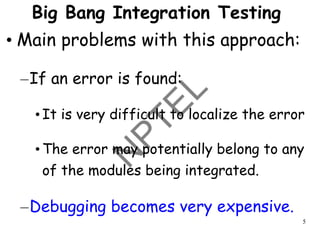




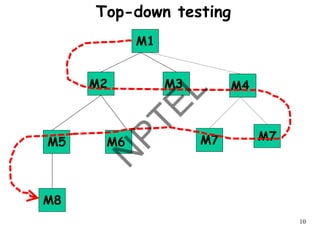
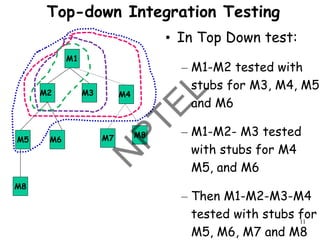





















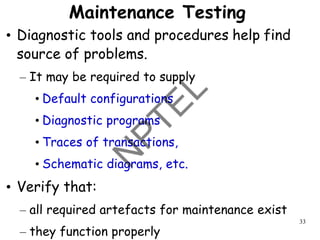













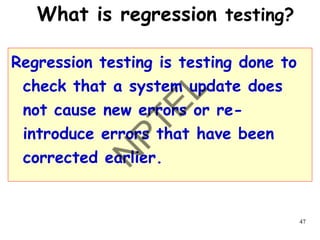










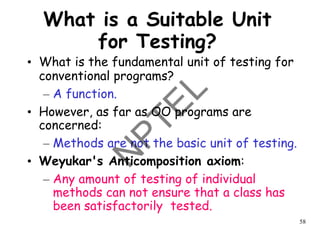


















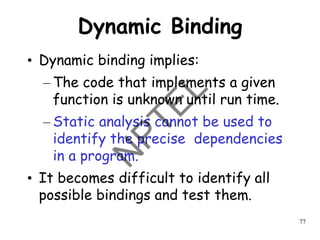





![83
An example of A State Model
Unprocessed
Order
Rejected
Order
Pending
Order
Fulfilled
Order
Accepted
Order
[reject] checked [accept] checked
[some items available]
Processed/deliver
[all items available]
newsupply
[some items not available]
Processed
Example: State chart diagram for an order object](https://image.slidesharecdn.com/softwaretestingw4watermark-220329050527/85/SOFTWARE-TESTING-W4_watermark-pdf-83-320.jpg)





